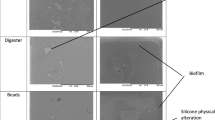Abstract
Background
Capsular fibrosis is a severe complication after breast implantation with an uncertain etiology. Microbial colonization of the prosthesis is hypothesized as a possible reason for the low-grade infection and subsequent capsular fibrosis. Current diagnostic tests consist of intraoperative swabs and tissue biopsies. Sonication of removed implants may improve the diagnosis of implant infection by detachment of biofilms from the implant surface.
Methods
Breast implants removed from patients with Baker grades 3 and 4 capsular contracture were analyzed by sonication, and the resulting sonication fluid was quantitatively cultured.
Results
This study investigated 22 breast implants (6 implants with Baker 3 and 16 implants with Baker 4 capsular fibrosis) from 13 patients. The mean age of the patients was 49 years (range, 31–76 years). The mean implant indwelling time was 10.4 years (range, 3 months to 30 years). Of the 22 implants, 12 were used for breast reconstruction and 10 for aesthetic procedures. The implants were located subglandularly (n = 12), submuscularly (n = 6), and subcutaneously (n = 4). Coagulase-negative staphylococci, Propionibacterium acnes, or both were detected in the sonication fluid cultures of nine implants (41%), eight of which grew significant numbers of microorganisms (>100 colonies/ml of sonication fluid).
Conclusions
Sonication detected bacteria in 41% of removed breast implants. The identified bacteria belonged to normal skin flora. Further investigation is needed to determine any causal relation between biofilms and capsular fibrosis.

Similar content being viewed by others
References
Araco A, Gravante G, Araco F, Delogu D, Cervelli V, Walgenbach K (2007) Infections of breast implants in aesthetic breast augmentations: a single-center review of 3,002 patients. Aesth Plast Surg 31:325–329
Burkhardt BR, Fried M, Schnur PL, Tofield JJ (1981) Capsules, infection, and intraluminal antibiotics. Plast Reconstr Surg 68:43–49
Darouiche RO (2004) Treatment of infections associated with surgical implants. N Engl J Med 350:1422–1429
Embrey M, Adams EE, Cunningham B, Peters W, Young VL, Carlo G (1999) A review of the literature on the etiology of capsular contracture and a pilot study to determine the outcome of capsular contracture interventions. Aesth Plast Surg 23:197–206
Ersek RA (1991) Rate and incidence of capsular contracture: a comparison of smooth and textured silicone double-lumen breast prostheses. Plast Reconstr Surg 87:879–884
Ersek RA, Salisbury AV (1997) Textured surface, nonsilicone gel breast implants: four years’ clinical outcome. Plast Reconstr Surg 100:1729–1739
Gabriel SE, Woods JE, O’Fallon WM, Beard CM, Kurland LT, Melton LJ 3rd (1997) Complications leading to surgery after breast implantation. N Engl J Med 336:677–682
Netscher DT (2004) Subclinical infection as a possible cause of significant breast capsules. Plast Reconstr Surg 113:2229–2230
Pajkos A, Deva AK, Vickery K, Cope C, Chang L, Cossart YE (2003) Detection of subclinical infection in significant breast implant capsules. Plast Reconstr Surg 111:1605–1611
Pittet B, Montandon D, Pittet D (2005) Infection in breast implants. Lancet Infect Dis 5:94–106
Ransjo U, Asplund OA, Gylbert L, Jurell G (1985) Bacteria in the female breast. Scand J Plast Reconstr Surg 19:87–89
Schreml S, Heine N, Eisenmann-Klein M, Prantl L (2007) Bacterial colonization is of major relevance for high-grade capsular contracture after augmentation mammaplasty. Ann Plast Surg 59:126–130
Spear SL, Baker JL Jr (1995) Classification of capsular contracture after prosthetic breast reconstruction. Plast Reconstr Surg 96:1119–1123
Trampuz A, Piper KE, Jacobson MJ, Hanssen AD, Unni KK, Osmon DR, Mandrekar JN, Cockerill FR, Steckelberg JM, Greenleaf JF, Patel R (2007) Sonication of removed hip and knee prostheses for diagnosis of infection. N Engl J Med 357:654–663
Acknowledgments
Part of this work was presented at the Annual Meeting of the Swiss Society of Plastic Reconstructive and Aesthetic Sugery (SGPRAC) in Montreux, Switzerland, September 2007. The presentation was elected to represent Switzerland in the "Best of Europe" Session for the Annual Meeting of the European Association of Societies of Aesthetic Plastic Surgery (EASAPS).
Author information
Authors and Affiliations
Corresponding author
Rights and permissions
About this article
Cite this article
Rieger, U.M., Pierer, G., Lüscher, N.J. et al. Sonication of Removed Breast Implants for Improved Detection of Subclinical Infection. Aesth Plast Surg 33, 404–408 (2009). https://doi.org/10.1007/s00266-009-9333-0
Received:
Accepted:
Published:
Issue Date:
DOI: https://doi.org/10.1007/s00266-009-9333-0



